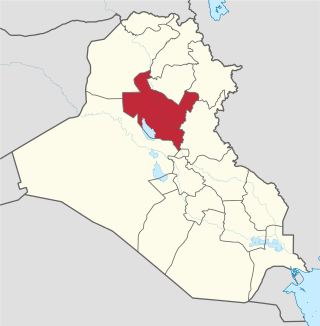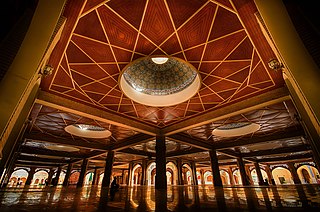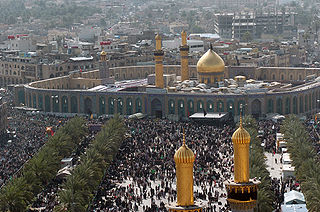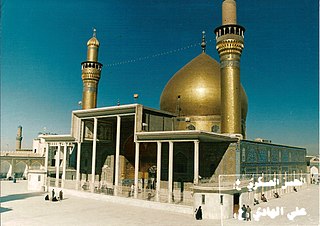
Najaf is the capital city of the Najaf Governorate in central Iraq, about 160 km (99 mi) south of Baghdad. Its estimated population in 2024 is about 1.41 million people. It is widely considered amongst the holiest cities of Shia Islam and one of its spiritual capitals, as well as the center of Shia political power in Iraq.

The Saladin, Salah ad Din, or Salah Al-Din Governorate is one of Iraq's 19 governorates, north of Baghdad. It has an area of 24,363 square kilometres (9,407 sq mi), with an estimated population of 1,042,200 people in 2003. It is made up of 8 districts, with the capital being Tikrit. Before 1976 the governorate was part of Baghdad Governorate.

Karbala is a city in central Iraq, located about 100 km (62 mi) southwest of Baghdad, and a few miles east of Lake Milh, also known as Razzaza Lake. Karbala is the capital of Karbala Governorate, and has an estimated population of 691,100 people (2024).

A shrine is a sacred space dedicated to a specific deity, ancestor, hero, martyr, saint, daemon, or similar figure of respect, wherein they are venerated or worshipped. Shrines often contain idols, relics, or other such objects associated with the figure being venerated. A shrine at which votive offerings are made is called an altar.

Kufa, also spelled Kufah, is a city in Iraq, about 170 kilometres (110 mi) south of Baghdad, and 10 kilometres (6.2 mi) northeast of Najaf. It is located on the banks of the Euphrates River. The estimated population in 2003 was 110,000. Currently, Kufa and Najaf are joined into a single urban area that is mostly commonly known to the outside world as 'Najaf'.

The Mahdi Army or Jaish Al-Imam Mahdi ' a'ajal allahu farajah ' or The Army of Imam Mahdi ' was an Iraqi Shia militia created by Muqtada al-Sadr in June 2003 and disbanded in 2008.

In Shia Islam, Arba'in marks forty days after Ashura, which is the martyrdom anniversary of Husayn ibn Ali, grandson of the Islamic prophet Muhammad and the third Shia imam. Husayn was killed, alongside most of his relatives and his small retinue, in the Battle of Karbala on 10 Muharram 61 AH against the army of the Umayyad caliph Yazid ibn Mu'awiya. The battle followed Husayn's refusal to pledge his allegiance to Yazid, who is often portrayed by Muslim historians as impious and immoral. In Shia Islam, Karbala symbolizes the eternal struggle between good and evil, the pinnacle of self-sacrifice, and the ultimate sabotage of Muhammad's prophetic mission.
The Imam al Husayn shrine is the mosque and burial site of Husayn ibn Ali, in the holy city of Karbala, Iraq. It stands on the site of the Mausoleum of Husayn, who was a grandson of Muhammad, near the place where he embraced martyrdom during the Battle of Karbala in 680 CE. The tomb of Husayn is one of the holiest sites in Shia Islam, outside of Mecca and Medina, and many make pilgrimages to the site. Every year, millions of pilgrims visit the city to observe Ashura, which marks the commemoration of Husayn's death for all Muslims.

Al-Askari Shrine, the 'Askariyya Shrine, or Al-Askari Mosque is a Shia Muslim mosque and mausoleum in the Iraqi city of Samarra 125 km (78 mi) from Baghdad. It is one of the most important Shia shrines in the world. It was built in 944. The dome was destroyed in a bombing by Sunni extremists in February 2006 and its two remaining minarets were destroyed in another bombing in June 2007, causing widespread anger among Shias and instigation of the Iraqi Civil War between the country's Shia and Sunni factions. The remaining clock tower was also destroyed in July 2007. The dome and minarets were repaired and the mosque reopened in April 2009.

At approximately 6:44 a.m. Arabia Standard Time on 22 February 2006, al-Askari Shrine in Samarra, Iraq, was severely damaged in a bombing attack amidst the then-ongoing Iraq War. Constructed in the 10th century, it is one of the holiest sites in Shia Islam. Despite the magnitude of the explosions, there were no casualties. American president George W. Bush asserted that the bombing had been carried out by Al-Qaeda in Iraq, which denied involvement in the attack.

Islam in Iraq has a rich complicated history that has come to be over almost 1,400 years, since the Prophet Muhammad lived and died in 632 CE. As one of the first places in the world to accept Islam, Iraq is mostly Muslim nation, with about 98% of the people identifying as Muslim. There are the two main types of Islam in Iraq: Shia Islam, which is practiced by about 55-60% of Muslims, and Sunni Islam, which is practiced by about 35-40%.

The holiest sites in Islam are located in the Arabian Peninsula. While the significance of most places typically varies depending on the Islamic sect, there is a consensus across all mainstream branches of the religion that affirms two cities as having the highest degree of holiness, in descending order: Mecca, and Medina. Mecca's Al-Masjid al-Haram, Al-Masjid an-Nabawi in Medina are all revered by Muslims as sites of great importance.

The Al-Abbas Shrine is the mausoleum of Abbas ibn Ali and a mosque, located near the Imam Husayn Mosque in Karbala, Iraq. Abbas was son of Ali ibn Abi Talib and the half-brother of Imam Hasan and Imam Husayn. He was Husayn's flag-bearer in the Battle of Karbala and chief of his caravans. The shrine is revered by the Shia Muslims who visit it every year, especially in the month of Muharram.

Muslims, including Shia, Sunni, Ibadi and other branches, agree on the three holiest sites in Islam being the Masjid al-Haram in Mecca; the Masjid an-Nabawi in Medina; and the Masjid Al-Aqsa in Jerusalem.

Shia Islam in Iraq has a history going back to the times of Ali ibn Abi Talib, the first imam of Shia Islam and fourth caliph of Sunni Islam who moved the capital of the early caliphate from Medina to Kufa two decades after the death of Muhammad. in Iraq there is no census established based on sect all the census was established based on Male and female rate so there is no rate of population.
Abū Jaʿfar Muḥammad ibn ʿAlī al-Hādī was a descendant of the Islamic prophet Muhammad and the son of Ali al-Hadi and the brother of Hasan al-Askari, the tenth and eleventh Imams in Twelver Shia, respectively. Some may have expected him to succeed his father al-Hadi to the imamate but he predeceased him in the garrison town of Samarra in Iraq, where al-Hadi was kept under surveillance by the Abbasids. His shrine is located near Baghdad, between Samarra and Kadhimiya. Considered a sacred site in Twelver Shia, his shrine was targeted by Sunni militants in 2016 in a deadly attack on its pilgrims.

The Arba'in pilgrimage is the world's largest annual public gathering. It is a pilgrimage to the shrine of Husayn ibn Ali, grandson of the Islamic prophet Muhammad and the third Shia imam. Every year, on the twentieth of Safar, also known as Arba'in, millions of pilgrims flock to Karbala, Iraq, often arriving there on foot from the nearby city of Najaf. Arba'in marks forty days after the tenth of Muharram, known as Ashura. On this day in 61 AH, Husayn was killed, alongside most of his relatives and his small retinue, in the Battle of Karbala against the army of the Umayyad caliph Yazid ibn Mu'awiya. The battle followed Husayn's refusal to pledge his allegiance to Yazid, who is often portrayed by Muslim historians as impious and immoral. In Shia Islam, Karbala symbolizes the eternal struggle between good and evil, the pinnacle of self-sacrifice, and the ultimate sabotage of Muhammad's prophetic mission.

Tourism in Iraq refers to tourism in the Western Asian country of Iraq. Iraq was one of the main destinations for many years, however this changed dramatically due to conflicts. Tourism in Iraq has faced many challenges, however, in recent years there have been improvements. The capital city Baghdad is the second largest city in the Arab world and the 4th largest in the Middle East. Iraq has several World Heritage Sites, dating back to ancient Mesopotamia, most notably Babylon Iraq. Iraq is considered to be a potential location for ecotourism. Erbil was chosen as "Arab Tourism Capital" in 2014 by the Arab Tourism Committee.

Al-Atabat Al-Aliyat, which is also known as Al-Atabat Al-Muqaddasa are the shrines of six Shia Imams which are in four cities of Iraq, namely Najaf, Karbala, Kadhimiya and Samarra; and actually the whole of these Imams' shrines (graves) are called Atabat Aliyat. The mentioned cities have significance due to shrines of those six Shia Imams who have been buried there.

The following is a timeline of the history of the city of Samarra, Iraq.





















